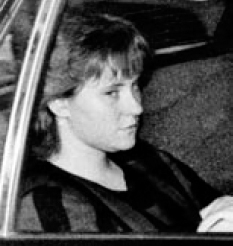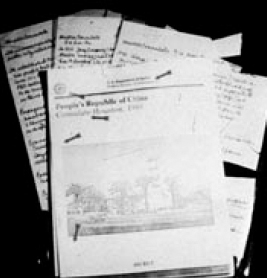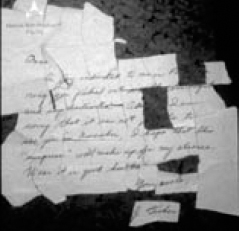![]()
Time was of the essence. Even before Pollard took his wife to the doctor on Thursday morning, the U.S. attorney for the District of Columbia, Joseph diGenova, was busy dealing with the Department of Justice. Other attorneys were drawing up search warrants for the suitcase Anne had left with her neighbors. Three assistant U.S. attorneys were assigned to prosecute the case, and they needed to gather the evidence required to connect Anne with the crime. Charles Leeper was the lead attorney in the Pollard case, David Geneson the lead in Anne’s case, while Stephen Spivack and other attorneys would assist. Anne hadn’t been arrested and was obviously trying to flee the country, which put a lot of pressure on Geneson.

Anne Pollard under arrest —AP/WWP
In the court records that later emerged, Geneson gave a meticulous description of events that unfolded that day and the next.1 Everyone at the U.S. attorney’s office was working frantically to patch together sufficient evidence to arrest Anne. They wanted to establish that she had known of her husband’s activities and had cooperated with him. After obtaining a search warrant from the Washington, D.C., magistrate, Geneson had FBI agents search the contents of the suitcase on Thursday afternoon and into the late evening. They couldn’t just page through the evidence. Each seized document had to be handled with gloves and packaged separately to prevent contamination so that the crime lab could obtain fingerprints and look for possible microdots, which had to be read using a microscope. With microdot technology, a page of instructions or documents could be photographed and reduced to a size less than one millimeter. It was quite sophisticated in its day and particularly popular with the Soviets, who used it to communicate detailed instructions to spies.
On Friday morning, with the clock ticking, several agents from the NIS and the FBI went to the U.S. attorney’s office in Washington to obtain three search warrants: one for Pollard’s Ford Mustang, another for his apartment, and the third for the small red bag and purse that Anne had carried with her to the Israeli embassy and that had been seized when she left. While the warrants were being prepared, Geneson interviewed NIS agent Lisa Redman and asked her to repeat what she had heard Pollard say the previous Monday when he called his wife and said “cactus.” That afternoon the word cactus was discovered in a copy of a paper seized from the suitcase. It was apparent to the attorneys that Pollard had used it as a code word to alert Anne to remove the documents from their residence. This critical piece of evidence suggested that she knew full well that the documents in the suitcase were classified.2
Hoping for more evidence, Geneson hurriedly dispatched agents to reinterview the Esfandiaris to see if they could recall any further details of their conversation with Anne on the night she left them with the suitcase. But the neighbors weren’t home, nor could they be found.
In the meantime, Anne, accompanied by her father-in-law, had dropped by the Central Detention Facility to try to bail her husband out. Because her purse had been seized at the embassy on Thursday, she had no identification to get through the door, much less to see Pollard. On the verge of panic, she spent the rest of the day making calls to the assistant U.S. attorney’s office in an attempt to reclaim her identification, credit cards, and cash. She pleaded on the phone with them, saying she needed her identification immediately to make an out-of-town business trip that had been scheduled prior to Pollard’s arrest. The very idea of a wife taking a business trip while her husband was sitting in jail on charges of suspected espionage was ludicrous, a clear signal that Anne intended to flee, and as a result the FBI tightened its surveillance knot. But her comment didn’t amount to evidence.
When the affidavits for permission to search the Pollards’ apartment were approved, NIS and FBI agents hustled over to Dupont Circle. During the ensuing search, they uncovered four documents classified confidential that we had missed on Monday night. Also recovered from the apartment were three large trash bags stuffed with hand-shredded papers. Later, working against the clock, the agents reconstructed some of these, including notes Anne had made on a notepad after reading the classified documents on the PRC. They also uncovered the note in which the fictitious Uncle Joe Fisher informed Anne that he wouldn’t be able to attend her wedding, and that he was sending her the diamond and sapphire engagement ring as a gift.

Anne Pollard’s handwritten notes transcribed from documents pertaining to China —NIS UNCLASSIFIED EVIDENCE PHOTO
Just when it seemed as if the case against Anne had solidified, the U.S. attorney’s office received an alarming phone call from one of the FBI agents surveilling her. He was at the jail, and had just been informed by a corrections officer that a bondsman was there at Anne’s request. Pollard was about to be released on bond.

Ficticious letter from Uncle Joe Fisher —NIS EVIDENCE PHOTO
Pandemonium broke out at the U.S. attorney’s office. How could this be? The court had a no-bond order for Pollard that was supposed to be in effect until the time of a preliminary hearing. Someone had dropped the ball.
In another flurry of phone calls, Geneson and his colleagues from the U.S. attorney’s office communicated with the magistrate court and the Department of Corrections and discovered that word of the no-bond order had never been communicated to the jail. Just minutes before Pollard was to be released, the order went through and the analyst stayed put.
It was a bureaucratic blunder that took valuable time away from the effort to get an arrest warrant for Anne. Not until 6:15 PM was the search warrant for her purse and bag executed. From that point on, the investigation unfolded rapidly—so rapidly it was difficult for the U.S. attorney’s office to keep track of what was going on. A search of Anne’s personal effects revealed identification papers for both her and Pollard. Included were vaccination records for her cat, estimates of the value of her jewelry, pictures of family and friends, even a giant bottle of expensive perfume. All of these items, the government believed, pointed to Anne’s desire to flee the country, taking with her what she valued and thought would be needed. By the time the agents finished going through her effects and all the trash, the government believed it had strong evidence that the Pollards had been attempting to make a clean getaway.
Sometime between 6:30 and 8:30 PM, while Anne was still at the jail, the Esfandiaris came home and underwent a second interview with NIS and FBI agents. They confirmed that on Monday evening, when Anne dropped off the suitcase, she had told them it contained classified documents, including some she had obtained for her presentation to the Chinese embassy.3 This gave Anne no out if she later lied in court, claiming to have no knowledge of the contents.
As soon as the Esfandiari interview was done and the search of Anne’s bag and purse documented, the FBI field office relayed the results to Geneson at the U.S. attorney’s office. Geneson in turn contacted the Department of Justice, providing them with the accumulated evidence against Pollard’s wife.
Losing no time, the attorney general’s office ordered her arrest. On Friday night at about nine, as she and Dr. Morris Pollard were climbing into a taxi outside the jail to go to get something to eat, two FBI agents approached and placed Anne Henderson Pollard under arrest.
It had never been Anne’s goal in life to achieve notoriety, but on 22 November 1985 she did just that. Her notoriety had less to do with her own crimes—committed for an engagement ring and the dubious promise of a more comfortable life, if not for love—than with the company she would join, for within the space of five short days, the FBI arrested Jonathan Pollard of the NIS, his neighbor Ronald Pelton of the NSA, and Larry Wu Tai Chin of the CIA.
While all this was going on, Minister of Defense Yitzhak Rabin was in New York continuing his lecture tour promoting Israeli bonds. Special Agent Al Zane, assistant special agent in charge of counterintelligence at the NIS’s New York field office, had been called to Washington to work on the Pollard case. On Friday he called Special Agent Ernie Simon at the New York office to see how Rabin’s protective service detail was going. Simon told him no one knew what was going on. The evening before, Rabin had been at Henry Kissinger’s townhouse in New York City when he’d received a cascade of telephone calls. Rabin left early, asking Simon to return him to his hotel. En route the defense minister told Simon there had been a change of plans and he had to leave for Israel the next morning. Simon made arrangements for an early departure on Friday.
Rabin and his entourage flew off in a commercial plane from a semiprivate airport in Teterboro, New Jersey, owned by the Port Authority of New York and New Jersey. According to Simon, this was not the airport through which Rabin had entered the United States. Normally, the minister of defense flew on private Israeli aircraft. It wasn’t until Simon found out about Pollard that he grasped the reason for Rabin’s sudden departure.4